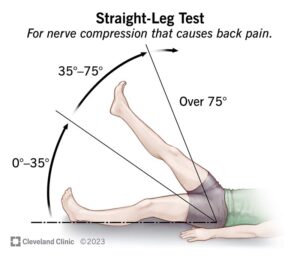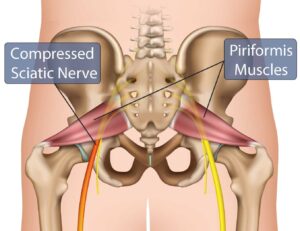Sciatica is a pain in the butt! It also can be a pain in your lower back, pain radiating down the back of your leg, sometimes even referring to your calf or toes.
It’s annoying, and when it’s flared up, it can ruin your life.
This article discusses sciatica, why it occurs, and how it is treated at ASR.
What is Sciatica/Sciatic Nerve Pain?
Sciatica is simply something causing pain to the sciatic nerve. The nerve can be compressed by something like the Piriformis or a bulging disc; it can irritated by swelling from an adjacent piece of anatomy, like the glutes. The diagnosis of sciatica is non-specific. All it means is that something is irritating your sciatic nerve and that you need to do some work to figure out what it is.
What is the Sciatic Nerve?
The Sciatic nerve is a thick, flat nerve band (approx. 2cm wide) originating from the spinal nerves, exiting from the L4-S3 and traveling down the leg to deliver and receive messages from the leg to the foot.
What are the causes of sciatica?
Sciatic pain (or sciatica) can occur for several reasons, ranging from sitting too much, lifting with bad form, doing too much too soon or something more acute like trauma. Some specific issues include:
- Herniated discs
- Stenosis (narrowing of the spinal canal)
- Previous injuries such as pelvic dysfunction or fractures
- Spondylolisthesis (slippage of vertebral body)
- Tumors
- Guarding from muscle spasms or prolonged positioning
- Poor lifting mechanics or inefficient movement
How is it diagnosed?

We differentiate between different causes of sciatica via orthopedic special tests, like the Straight-Leg Tests. We also may order an x-ray or MRI if the special test results are unclear.
Who experiences this frequently?
-People who sit often
-People who are out of shape
-People who lift heavy things without enough tensile strength in the tissues to support the effort
-Lifting with poor mechanics
How Does Atlanta Sports Recovery Treat Sciatica?
We start by finding out what is causing the pain (i.e., muscle, disc, etc) and if there is a movement pattern that you commonly do that sensitizes the nerve.
Once we locate the root cause, we do things to make the pain go away. Techniques like cupping, joint mobilizations, dry needling, shockwave, or good old-fashioned manual muscle work depend on what structure we are treating. Of course, we will also teach you some techniques to help you manage flare-ups at home so you don’t get shut down from sciatica again.
After you are out of pain, we make you bulletproof by utilizing tailored exercise programs to build a resilient core, glutes, lower back, and more.
Does the pain ever subside?
Yes! It takes 4-6 weeks after you start getting treated to be 100%, but you will heal.
Don’t let sciatica keep you from moving.
Atlanta Sports Recovery is ready to eliminate your pain and make you better than ever.




